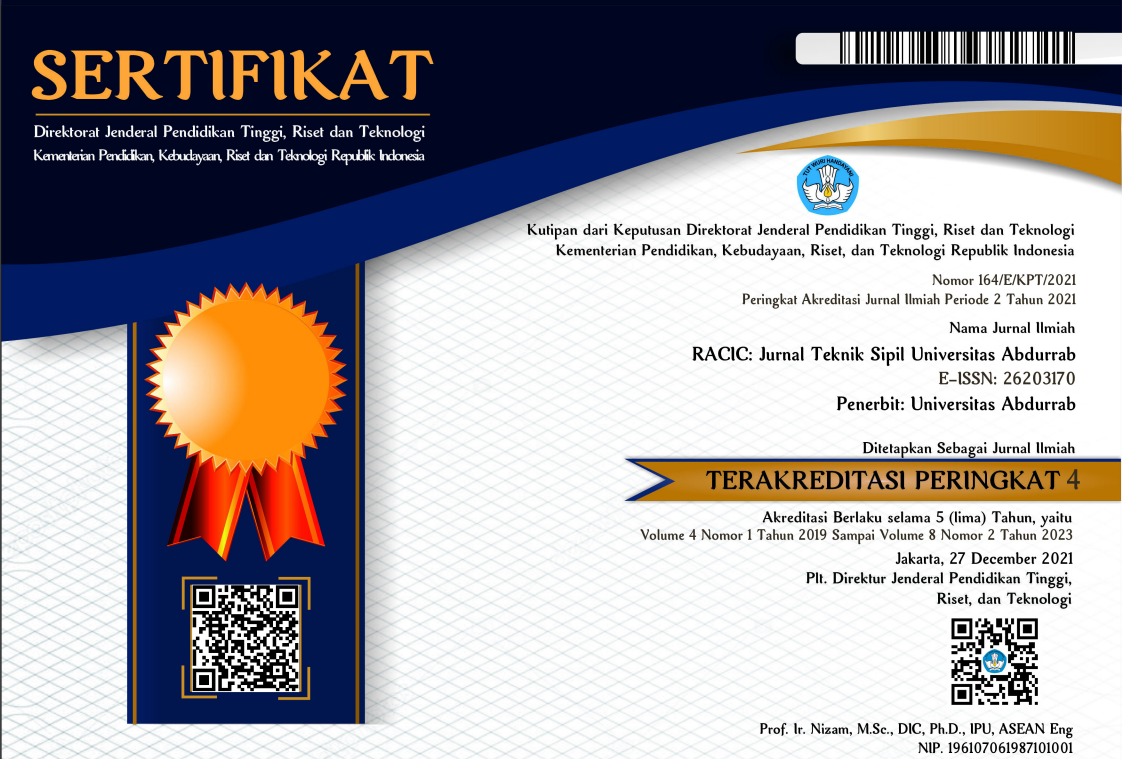PERILAKU STRUKTUR LANTAI PSSDB (PROFILED STEEL SHEET DRY BOARD) DENGAN LUBANG BULAT DITENGAH
Keywords:
PSSDB, BONDEK II, Opening, DeflectionAbstract
The knowledge on the behaviour of a building structure is very important in order to predict the behaviour of the structure before it is constructed. This is to ensure that the structure is safe to be used. New current modern technology is now able to predict the behaviour of a structure through computer simulation as a replacement to laboratory tests. However, laboratory tests will also have to be performed in order to validate the proposed computer models. This thesis illustrates the prediction of the structural behaviour of Profiled Steel Sheet Dry Board (PSSDB) which is a structural composite floor system constructed of Bondek II (profiled steel sheeting), Cemboard (dry board) connected via Power Drive DX14 (self drilling, self tapping screws). The floor structure is loaded with a uniformly distributed loading and its behaviour due to the openings at the center of the panel analysed using a finite element perangkat lunak package, LUSAS-FE. The one-way spanning plate have been analysed in this research. The increase in deflection in the longitudinal direction is found to be more influenced by the presence of the opening than the deflection in the transverse direction. The average percentage of the increase in deflection of the one-way spanning plate due to the presence of 20%, 40%, and 60% opening of its overall width are 36%, 108%, and 184% respectively in comparison to the deflection of plate without opening. It has been found that as the size of opening increases, the deflection also increased.
Downloads
References
Ahmed, E. 1996. Behaviour of profiled steel sheet dry board panel. MSc Thesis. Universiti Kebangsaan Malaysia.
Ahmed, E., Wan Badaruzzaman, W.H. & Rashid, K. 1996. A simplified elastic composite floor section analysis with incomplete interaction. Jurnal Kejuruteraan 8: 67-78
Ahmed, E. 1999. Behaviour of profiled steel sheet dry board folded plate structures. PhD Thesis. Universiti Kebangsaan Malaysia.
Ahmed, E., Wan Badaruzzaman, W.H. & Wright, H.D. 2000. Experimental and finite element study of profiled steel sheet dry board folded plate structures. Thin-walled Structures 38(2): 125–43.
Ahmed, E., Wan Badaruzzaman, W.H. & Wright, H.D. 2002. Two-way bending behaviour of profiled steel sheet dry board composite panel system. Thin-walled Structure 40: 971-990.
Akhand, A.M. 2001. Nonlinear finite element analysis for continuous floor. PhD Thesis. Universiti Kebangsaan Malaysia.
Harsoyo, M.S. 2004. Prestasi sistem lantai baru keluli berprofil papan kering dengan isian konkrit. Tesis PhD. Universiti Kebangsaan Malaysia.
LUSAS. 1999. Lusas modeller user manual. Version 13. United Kingdom. FEA Ltd.
Newmark, N.M., Sies, C.P. & Viest, I.M. 1951. Test and analysis of composite beams with incomplete interaction. Proc. Society for Experimental Stress Analysis 9(1): 75-95.
Wan Badaruzzaman, W.H. 1994. The behaviour of profiled steel sheet/dry board system. PhD Thesis. Cardiff University of Wales.
Wan Badaruzzaman, W.H. & Wright, H.D. 1998. Lightweight thin walled profiled steel sheeting/dryboard composite floor system. In: Proceedings of the 2nd International Conference on Thin-Walled Structures: Research and Development: 355-65.
Wan Badaruzzaman, W.H., Zain, M.F.M., Akhand, A.M. & Ahmed, E. 2003a. Dry board as load bearing element in the profiled steel sheet dry board floor panel system. Construction and Building Material 17: 289-297.
Wan Badaruzzaman, W.H., Zain, M.F.M., Shodiq, H.M., Akhand, A.M. & Sahari, J. 2003b. Fire resistance performance of profiled steel sheet dry board (PSSDB) flooring panel system. Building and Environment 38: 907-912.
Downloads
Published
Issue
Section
License
1. Copyright of all journal manuscripts is held by the RACIC : Rab Construction Research
2. Formal legal provisions to access digital articles of electronic journal are subject to the provision of the Creative Commons Attribution-ShareAlike license (CC BY-NC-SA), which means that RACIC : Rab Construction Research is rightful to keep, transfer media/format, manage in the form of databases, maintain, and publish articles.
3. Published manuscripts both printed and electronic are open access for educational, research, and library purposes. Additionally, the editorial board is not responsible for any violations of copyright law.
licensed under a Creative Commons Attribution-ShareAlike 4.0 International License.





